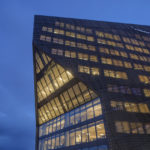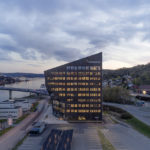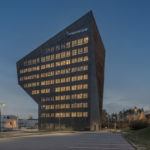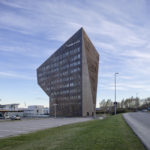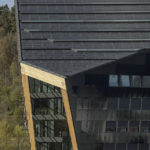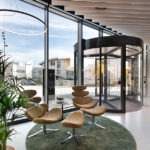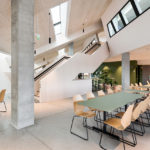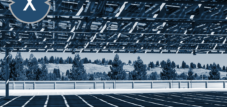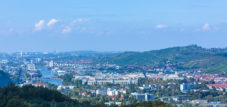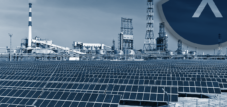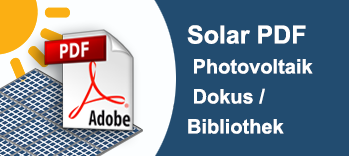Climate neutrality: The climate goal in Norway is for buildings to be CO2-neutral by 2050
Language selection 📢
Published on: August 20, 2021 / update from: August 20, 2021 - Author: Konrad Wolfenstein
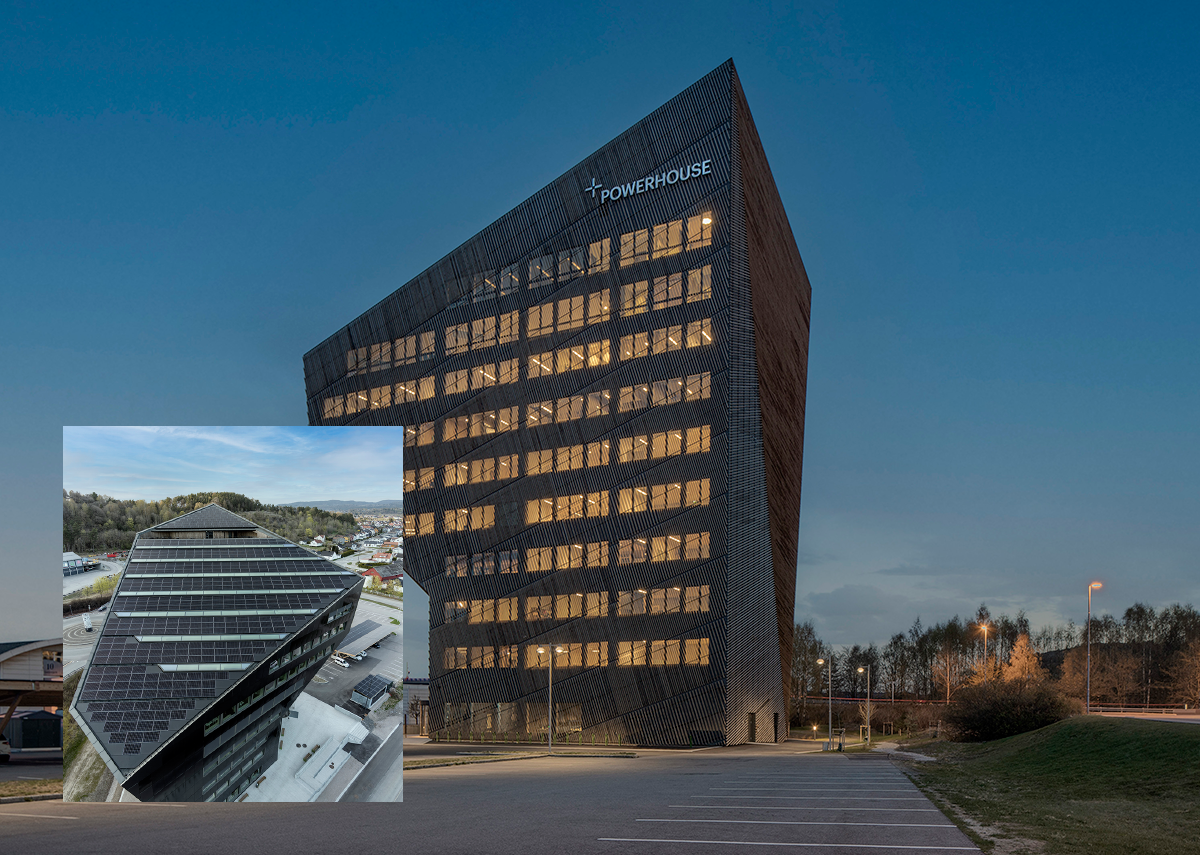
CO2-neutral building “Powerhouse Telemark”-photographer: Sindre Ellingsen / right of use: Schüco International KG
Norway's climate protection goals are ambitious. The aim is to have an almost CO2-neutral building stock by 2050. A groundbreaking impetus for the decarbonization of new office buildings is the “Powerhouse Telemark,” which offsets its carbon footprint over the entire life cycle. The innovative facade solution is of central importance.
The striking silhouette of the “Powerhouse Telemark” is visible far beyond the horizon of the industrial town of Porsgrunn. When the sun shines, the eleven-story office tower sparkles like an XXL-sized amber-colored diamond, whose roof terrace offers a brilliant view of the regional center of the province of Telemark, which has around 35,000 inhabitants, and the Frierfjord. Completed in summer 2020, the zero-emissions building has become a symbol of the transition to a green economy in the region, which is located about 150 kilometers south of Oslo and has a long history as a progressive business location. The UNESCO World Heritage Site of Vemork, which is located in the same province as Porsgrunn, is home to one of the largest hydroelectric power plants of the early 20th century. The location couldn’t be more suitable for a “powerhouse”.
"Powerhouse Telemark"
- On the building entrance side, which is decorated with a striking notch, the Schüco facade system FWS 50 SG.SI demonstrated the greatest possible design freedom while at the same time being the best possible environmental compatibility - Photographer: Sindre Ellingsen / Usage rights: Schüco International KG
- The eleven-story zero-emission building is located directly on the Porsgrunnselva River - Photographer: Sindre Ellingsen / Rights of use: Schüco International KG
- The “Powerhouse Telemark” is already the fourth Powerhouse in Norway, but the first office building of this kind in a smaller town - photographer: Sindre Ellingsen / right of use: Schüco International KG
- An integrated building, energy, facade and interior design reduces the energy requirements of the solar self-sufficiency by up to 70 percent compared to that of comparable new buildings - Photographer: Sindre Ellingsen / Rights of use: Schüco International KG
- Vertical glass slots are integrated into the building roof, providing the three upper office floors with daylight - Photographer: Sindre Ellingsen / Usage rights: Schüco International KG
- The angled southeast facade, which runs diagonally upwards, was also equipped with photovoltaic modules. Every year, all of the Powerhouse's modules produce around 243,000 kilowatt hours of solar power - Photographer: Sindre Ellingsen / Rights of use: Schüco International KG
- In order to capture the maximum amount of sunlight, the roof surface with the integrated photovoltaic modules was tilted towards the south - Photographer: Sindre Ellingsen / Rights of use: Schüco International KG
- All pieces of furniture have been checked in detail for their climate friendliness so that nothing upsets the CO2 balance - photo credit: THT Photo / R8 Property
- Standardized interior solutions and co-working spaces offer the opportunity to scale office spaces as needed to be flexible and implement remote working concepts - Image credit: THT Photo / R8 Property
- On the ninth floor, a striking staircase connects the canteen with the meeting rooms and not only invites people to walk, but also promotes chance encounters and thus communication between users - photo credit: THT Photo / R8 Property
- The eleven-story zero-emission building is located directly on the Porsgrunnselva River.
- The “Powerhouse Telemark” is already the fourth Powerhouse in Norway, but the first office building of this kind in a smaller town.
- An integrated building, energy, facade and interior design reduces the solar self-sufficiency's energy requirements by up to 70 percent compared to comparable new buildings.
- Vertical glass slots are integrated into the building roof, providing the three upper office floors with daylight.
- On the building entrance side, which is decorated with a striking notch, the Schüco facade system FWS 50 SG.SI demonstrated the greatest possible freedom of design while at the same time offering the best possible environmental compatibility.
- The angled southeast facade, which runs diagonally upwards, was also equipped with photovoltaic modules. Every year, all of the Powerhouse's modules produce around 243,000 kilowatt hours of solar power.
- In order to capture the maximum amount of sunlight, the roof surface with the integrated photovoltaic modules was tilted towards the south.
- All pieces of furniture have been tested in detail for their climate friendliness so that nothing upsets the CO2 balance.
- Standardized interior solutions and co-working spaces offer the opportunity to scale office spaces as needed to be flexible and implement remote working concepts.
- On the ninth floor, a striking staircase connects the canteen with the meeting rooms and not only invites people to walk, but also promotes chance encounters and thus communication between users.
243,000 kilowatt hours all included
The powerhouse is not just an eye-catcher in terms of architecture. The energy performance is also remarkable, as the energy concept “Powerhouse Telemark: A plus energy building with a low exergy heating and cooling system” by the engineers from Skanska Norway shows. The calculated 243,000 kilowatt hours of solar power that the approximately 8,400 square meter office building generates per year includes, on the one hand, the operating energy that is necessary for the ongoing maintenance of the building and, on the other hand, the gray energy that is contained in the materials used, so that the CO2 -The balance sheet of the building is balanced after an assumed useful life of 60 years. The highlight: an integrated building, energy, facade and interior design reduces the solar self-sufficiency's energy requirements by up to 70 percent compared to comparable new buildings. What sounds unique is ready for series production: The “Powerhouse Telemark” is already the fourth powerhouse in Norway, but the first office building of its kind in a smaller town. Emil Eriksrød, managing director of R8 Property, wants to change that.
An investor with vision
The zero -emission building, which is awarded with the “Breeam Excellent” sustainability certificate, is intended to serve as a source of inspiration for future -proof zero -emission buildings, especially beyond large cities such as Oslo and Trondheim, where such objects arise anyway. The need for action is large everywhere: in 2017, the Norwegian construction industry issued almost 13 million tons of CO2, which corresponds to the amount of climate-damaging greenhouse gases that caused the oil and gas industry during this period. If Norway wants to achieve its climate protection goals, it is high time for the industry to rethink. The future has long started at R8 Property, because visionary Eriksrød founded the company in 2010 because it wanted to explicitly develop sustainable office properties in which people like to work. Success proves him right: R8 Property has been leading the "Norwegian Tenant Index" since 2015 and is considered one of the most popular office tenants nationwide.
Zero emissions as a mission
Review: The successful “Powerhouse Telemark” project began with R8 Property's office space at its headquarters in Porsgrunn on the banks of the Porsgrunnselva reaching its capacity limits and there was no longer any space in the building to adequately accommodate new tenants, which is why an alternative had to be found . Since there was a plot of land that was suitable for development next to the company headquarters, the answer was quickly found: This is where the new head office will be, whose spacious office space is maximally flexible, meets the most modern requirements for climate protection and offers inspiring work spaces. A lighthouse is to be built with radiance in the region and beyond. So much for the theory. The Powerhouse initiative came on board for practical purposes. The alliance, founded by renowned representatives of the Norwegian construction industry, includes the property developer Entra, the Skanska construction group, the engineering company Asplan Viak, the environmental organization Zero and the architecture and design firm Snøhetta, which specializes in sustainable construction. Together they create zero-emission buildings that are characterized by the greatest possible user-friendliness and cost-effectiveness. Unlike conventional plus-energy houses, whose energy concept is primarily aimed at an energy-efficient operating phase and the reduction of the resulting CO2 emissions, the design of a “powerhouse” focuses on avoiding any greenhouse gases that the building emits over its entire life cycle - i.e. from planning to construction and use until dismantling – emitted. As a result, the planning process basically takes place holistically and integrally, instead of, as is usually the case, trade by trade.
First simulate, then design
So the planners put their heads together. Firstly, they had to ensure that the building would run on climate-friendly energy. It was essential to make the best possible use of daylight in order to avoid artificial light sources as much as possible. Because lighting is usually a significant energy guzzler in office buildings. In order to reduce the need to an absolute minimum, Snøhetta's creative team designed a lighting concept that only required 2.3 watts per square meter and a spatial concept that creates a stimulating atmosphere from the interplay of light and shadow and the flowing transitions between different work situations . The building roof also received vertical glass slots, which provide the three upper office floors with daylight. Secondly, the energy requirements for heating and cooling had to be determined. Thirdly, it was necessary to analyze how much CO2 is caused by the production of the intended materials and products, how much greenhouse gases are produced during the regular replacement of components and how large the amount of CO2 is in the event of disposal in order to calculate the gray energy. All values added together resulted in the energy concept to be developed. The digital building model was worked on using BIM. For the complex calculations, the energy simulation software Simien v 6.009 and a calculation tool based on DIN EN ISO 11855-2 (EU standard for environmentally friendly building planning) were used. The result: Take a very well thermally insulated building shell, combine it with actively generated renewable energies that are connected to a circular system, support the whole thing with a low-tech approach and primarily use resource-saving, recycled building and materials.
Balanced climate balance with solar power
The (i)conical building shape not only looks good visually. It is also advantageous from an energy perspective: In order to capture the maximum amount of sunlight, the roof surface was impressively tilted by 24 degrees to the south and equipped with highly efficient integrated photovoltaic modules from the Danish company SolarLab with an efficiency of 22 percent and an output of 210 kilowatts peak . The angled southeast façade, which runs diagonally upwards, was given the same equipment, as was the roof of the carport next to the building. Every year, the almost 1,500 square meter module area produces around 243,000 kilowatt hours of solar power: of this, just under 50,000 kilowatt hours are used for operational energy, while around 193,000 kilowatt hours remain to offset the climate balance, which are temporarily stored in the in-house 130 kilowatt hour electricity storage system. Excess energy produced is fed into the car charging stations and thus back into the electrical circuit. Over a lifespan of 60 years, the plus-energy house generates almost 15 million kilowatt hours of CO2-neutral electricity. This makes the “Powerhouse Telemark”, based on the information in “Norway: Heating and cooling of commercial and industrial buildings with renewable energies”, published by the German-Norwegian Chamber of Commerce in Oslo, currently one of the most effective solar power plants in Norway.
Proven environmental compatibility as a success factor
The widely used Schüco façade system FWS 50.HI was used for the light roof construction, with which large spans can be realized in an architecturally appealing manner, especially in large projects such as shopping centers, office and administration buildings and hotels. The decisive factor for planners and building owners in choosing this solution was the proven environmental compatibility of the materials through certification according to the Cradle-to-Cradle product standard. Cradle-to-Cradle-certified systems can also be returned to the recycling cycle as often as required after their use phase and meet high standards in terms of compliance with social standards and the careful use of water and energy in production. In order to make the large, sloping window front in the lower section of the southeast facade as elegant as possible, to maximize daylight and to use sustainable products, the decision was also made in favor of the cradle-to-wall for other parts of the building shell. Cradle-certified facade system Schüco FWS 50 SG.SI. The semi-structural glazing look with a narrow visible width of just 50 mm ensures that the profiles are only visible in the room and appear on the outside in a flush all-glass look with filigree joints, which gives the powerhouse a graceful appearance, contrary to what its name suggests gives. The solution chosen for the building entrance side, which is adorned with a striking notch, is also visually extremely distinctive. Here too, the Schüco facade system FWS 50 SG.SI demonstrated the greatest possible freedom of design while at the same time being the best possible environmental compatibility.
The highly thermally insulated windows and curtain walls with triple insulating glazing are impressive both in terms of design and technology, as they ensure the lowest thermal characteristics: The heat transfer coefficient of all windows (Uw values) and curtain walls (Ucw values), including the frame profiles and glazing, is 0.75 W/m²K, the overall energy transmittance (g value) of the glazing is 37 percent and in terms of daylight transmission it is 63 percent.
Ecodesign makes the difference
When selecting materials, environmental compatibility and durability were also given top priority in order to save as much CO2 as possible. The Schüco FWS facade system made of aluminum impressed not only with its Cradle-to-Cradle certificate in silver, but also with its 100% recyclability without loss of quality. In addition, other advantageous properties of the material were decisive for the choice of the facade system, for example its lightness combined with very high stability, its high corrosion resistance thanks to anodization and its insensitivity to temperature fluctuations. These are all extremely beneficial features for a positive CO2 balance. A fair amount of creativity was also required. The wooden floor, for example, consists of industrial parquet made from wood waste. The carpet tiles are made from 70 percent old fishing nets. The untreated, exposed concrete exudes a rough charm. From the office desk to the kitchen furniture, climate friendliness was checked down to the smallest detail so that nothing would upset the CO2 balance. A special signage system with environmentally friendly foiling was even designed, allowing office spaces to be visually identified without producing unnecessary waste.
Heat comes from 300 meters deep
Geothermal energy ensures a comfortable temperature of 21.5 degrees Celsius in the building. Integrated into a “LowEx” system, which is based on optimally coordinated low-temperature heating and high-temperature cooling, which means that the electricity requirement is extremely low, a highly efficient heat pump taps into the existing heat inside the earth via eight geothermal probes from a depth of 300 meters. The yield is so significant that almost 100 percent of the energy required to heat and ventilate the rooms is covered. The earth drillings are among the deepest to date for the use of geothermal heat in Norway and show that the oil and gas industry's knowledge of drilling technology and geology can be used in the future to develop geothermal energy and thus climate-friendly energy.
Interior design opens up possibilities
The interior configuration was also carefully done. Two spacious, open staircases lead from the reception area on the ground floor to the shared staff canteen and the penthouse meeting rooms to the top floors. This not only encourages people to travel on foot and do something for their circulation, but also promotes chance encounters and thus communication between users. On the ninth floor, a striking wooden staircase connects the canteen with the meeting rooms and leads out to the roof terrace, from where there are wonderful views of the fjord. Standardized interior solutions and co-working spaces offer tenants the opportunity to scale their office spaces as needed to be flexible and implement remote working concepts. The smartphone app from the Orbit software solution can be used to personalize various applications, such as check-in, room booking or visitor registration.
The enthusiasm with which the tenants use the building strengthens R8 Property boss Eriksrød in his belief that he has built the right office property in the right place at the right time. So: Full speed ahead for the climate-friendly and user-friendly powerhouse!
Construction board
Object: Telemark
Location: Porsgrunn, Telemark Province
Country: Norway
Planning/construction period: 2015 - 2020
Gross floor area (GFA): 8,403 m²
Client: R8 Property, Porsgrunn, Norway
Architects: Snøhetta, Oslo, Norway
Energy concept: Skanska AB, Oslo, Norway
Technical building equipment: Asplan Viak AS, Sandvika, Norway
Specialist company: H-fasader AS
Project development: Entra Eiendom AS, Oslo
SCHÜCO International KG
The Schüco Group, headquartered in Bielefeld, develops and sells system solutions for windows, doors and facades. With 5,650 employees worldwide, the company is working to be the technology and service leader in the industry today and in the future. In addition to innovative products for residential and work buildings, the building envelope specialist offers advice and digital solutions for all phases of a construction project - from the initial idea through planning and production to assembly. 10,000 craft businesses and 30,000 architectural offices as well as construction professionals who commission the construction of a building work with Schüco worldwide. Founded in 1951, the company is now active in more than 80 countries and generated annual sales of 1.695 billion euros in 2020. Further information at www.schueco.de



